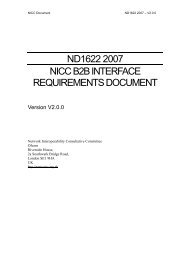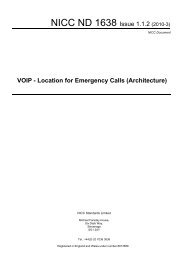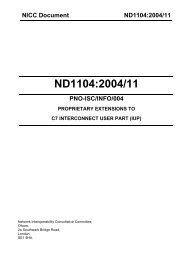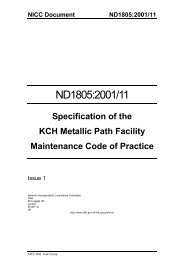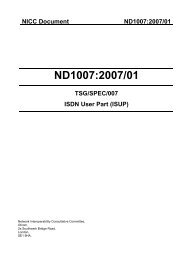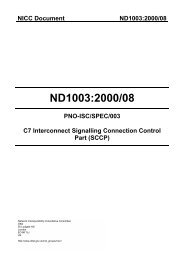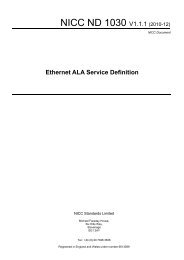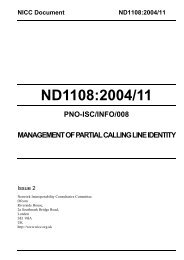âWires-onlyâ VDSL2 Modem Test Plan - NICC
âWires-onlyâ VDSL2 Modem Test Plan - NICC
âWires-onlyâ VDSL2 Modem Test Plan - NICC
You also want an ePaper? Increase the reach of your titles
YUMPU automatically turns print PDFs into web optimized ePapers that Google loves.
6<br />
<strong>NICC</strong> ND 1436 V1.1.2 (2013-09)<br />
1 Scope<br />
ND1436 is a test plan for a <strong>VDSL2</strong>-based modem device intended for connection in the UK to a<br />
wires-only UNI, as described in part in ND1031[11]. The test plan details tests which, if passed,<br />
will give a high degree of confidence that the attachment of the device will: a) not cause network<br />
harm and b) will deliver the necessary <strong>Test</strong> and Diagnostic (T&D) functionality, and c)<br />
interoperate with <strong>VDSL2</strong> DSLAMs in use by appropriate CPE <strong>Modem</strong> Providers. This will allow<br />
the Access Node Operators, MPF Providers and CPE <strong>Modem</strong> Providers to continue to operate<br />
an efficient and scalable service, with minimal impact on Trouble To Resolve (T2R) processes<br />
designed for the fully managed install variant. ND1436 draws on requirements defined in<br />
ND1031 and other Access Node Operator and MPF Provider specific requirements to define the<br />
minimal set of tests. ND1436 does not define the expected level of Layer 1 transmission<br />
performance for <strong>VDSL2</strong> lines deployed according to wires-only operation.<br />
2 References<br />
For the particular version of a document applicable to this release see ND1610 [1].<br />
2.1 Normative references<br />
The following referenced documents are indispensable for the application of this document. For<br />
dated references, only the edition cited applies. For non-specific references, the latest edition of<br />
the referenced document (including any amendments) applies.<br />
[1] <strong>NICC</strong> ND1610 Next Generation Networks, Release Definition, V.3.1.z<br />
[2] BT SIN 498, Version 5, July 2013: “Generic Ethernet Access Fibre to the Cabinet<br />
(GEA-FTTC) Service and Interface Description”<br />
[3] ITU-T Recommendation G.993.2: “Very high speed digital subscriber line<br />
transceivers 2 (<strong>VDSL2</strong>)”<br />
[4] Broadband Forum Technical Report TR-114 Issue 2, November 2012 “<strong>VDSL2</strong><br />
Performance <strong>Test</strong> <strong>Plan</strong>”<br />
[5] Broadband Forum Technical Report TR-115 Issue2, July 2012: “<strong>VDSL2</strong><br />
Performance <strong>Test</strong> <strong>Plan</strong>”<br />
[6] <strong>NICC</strong> ND1602 : Specification of the Access Network Frequency <strong>Plan</strong> (ANFP)<br />
Applicable to Transmission Systems Used on the BT Access Network.<br />
http://www.niccstandards.org.uk/files/current/ND1602-2011-<br />
09_v5.1.1.pdf?type=pdf<br />
[7] ETSI TS 101 270-1 : Transmission and Multiplexing (TM);Access transmission<br />
systems on metallic access cables; Very high speed Digital Subscriber Line<br />
(VDSL);Part 1: Functional requirements<br />
[8] ITU-T Recommendation G.994.1: “Handshake procedures for digital subscriber<br />
line (DSL) transceivers”<br />
<strong>NICC</strong> Standards Limited



